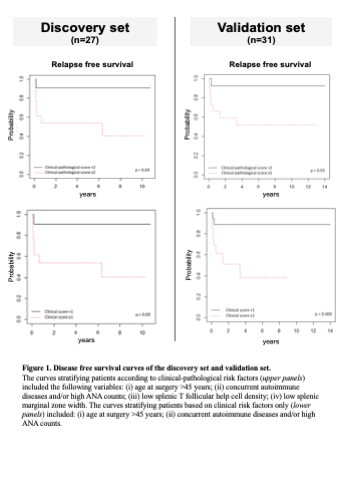
Contributions
Abstract: EP1129
Type: E-Poster Presentation
Session title: Platelet disorders
Background
Splenectomy is a valuable second-line therapy for primary Immune Thrombocytopenia (ITP), with response rates exceeding 60% of cases. It is nonetheless an invasive procedure with potentially severe side effects (thrombotic events, major bleeding and life-threatening infections). At present, there are no validated predictors of splenectomy response in ITP. Their identification may nonetheless help identify ITP patients with the highest chances of benefitting from this procedure.
Aims
This study was aimed at identifying possible clinical-pathological predictors of splenectomy outcome in primary adult ITP.
Methods
A discovery set of 27 clinically-annotated ITP spleens from Padua University Hospital (Padua – Italy) was histologically assessed for the following parameters: (i) density of lymphoid follicles; (ii) width of peri-follicular marginal zones; (iii) density of T regulatory, Th1, Th2, cytotoxic T cells and Cd207/PD1-positive T-cells (which include T follicular helper cells; (iv) width of perivascular T cell sheaths; and (v) red pulp features (plasma cell, histiocyte and sinusoid density). Splenectomized ITP patients were stratified into responder and non-responder subgroups based on IWG consensus criteria and clinical-pathological data were matched to identify possible predictors of surgical outcome. The obtained results were validated in an additional set of 31 ITP patients from Sant’Orsola University Hospital (Bologna – Italy) and San Bortolo Hospital (Vicenza - Italy). Statistical analysis was performed by non-parametric tests for quantitative (Mann-Whitney-Wilcoxon test) and qualitative (Fisher’s exact test) variables. Kaplan-Meyer and log rank methods were used for survival analyses. Differences between groups were considered statistically significant for p-values <0.05.
Results
The discovery set consisted of 9/27 (33.3%) males and 18/27 (66.7%) females with mean age at surgery of 36 years (range: 18-67 years). Histological evaluation of ITP spleens documented heterogeneous morphology, spanning from white pulp hyperplasia to marked lymphoid atrophy. No single clinical-pathological parameter predicted splenectomy outcome. However, the combination of multiple variables (i.e. age at surgery >45 years; concurrent autoimmune diseases and/or high ANA counts; low splenic Cd207/PD1-positive T-cell density (which include T follicular helper cells); low splenic marginal zone width) efficiently stratified patients into splenectomy response groups. Indeed, the occurrence of ≥2 clinical-pathological (left upper panel) or ≥1 clinical risk factors (left lower panel) was associated with significantly worse splenectomy outcome (p <0.05;). These results were confirmed in a validation set of 31 ITP cases, which included 14/31 (45.2) males and 17/31 (54.8%) females with mean age at surgery 33 years (range: 19-69 years) (Right panels). Splenectomy response did not correlate with prior medical therapies.

Conclusion
The integration of clinical-pathological parameters may predict splenectomy outcome, contributing to the management of ITP patients.
Keyword(s):
Abstract: EP1129
Type: E-Poster Presentation
Session title: Platelet disorders
Background
Splenectomy is a valuable second-line therapy for primary Immune Thrombocytopenia (ITP), with response rates exceeding 60% of cases. It is nonetheless an invasive procedure with potentially severe side effects (thrombotic events, major bleeding and life-threatening infections). At present, there are no validated predictors of splenectomy response in ITP. Their identification may nonetheless help identify ITP patients with the highest chances of benefitting from this procedure.
Aims
This study was aimed at identifying possible clinical-pathological predictors of splenectomy outcome in primary adult ITP.
Methods
A discovery set of 27 clinically-annotated ITP spleens from Padua University Hospital (Padua – Italy) was histologically assessed for the following parameters: (i) density of lymphoid follicles; (ii) width of peri-follicular marginal zones; (iii) density of T regulatory, Th1, Th2, cytotoxic T cells and Cd207/PD1-positive T-cells (which include T follicular helper cells; (iv) width of perivascular T cell sheaths; and (v) red pulp features (plasma cell, histiocyte and sinusoid density). Splenectomized ITP patients were stratified into responder and non-responder subgroups based on IWG consensus criteria and clinical-pathological data were matched to identify possible predictors of surgical outcome. The obtained results were validated in an additional set of 31 ITP patients from Sant’Orsola University Hospital (Bologna – Italy) and San Bortolo Hospital (Vicenza - Italy). Statistical analysis was performed by non-parametric tests for quantitative (Mann-Whitney-Wilcoxon test) and qualitative (Fisher’s exact test) variables. Kaplan-Meyer and log rank methods were used for survival analyses. Differences between groups were considered statistically significant for p-values <0.05.
Results
The discovery set consisted of 9/27 (33.3%) males and 18/27 (66.7%) females with mean age at surgery of 36 years (range: 18-67 years). Histological evaluation of ITP spleens documented heterogeneous morphology, spanning from white pulp hyperplasia to marked lymphoid atrophy. No single clinical-pathological parameter predicted splenectomy outcome. However, the combination of multiple variables (i.e. age at surgery >45 years; concurrent autoimmune diseases and/or high ANA counts; low splenic Cd207/PD1-positive T-cell density (which include T follicular helper cells); low splenic marginal zone width) efficiently stratified patients into splenectomy response groups. Indeed, the occurrence of ≥2 clinical-pathological (left upper panel) or ≥1 clinical risk factors (left lower panel) was associated with significantly worse splenectomy outcome (p <0.05;). These results were confirmed in a validation set of 31 ITP cases, which included 14/31 (45.2) males and 17/31 (54.8%) females with mean age at surgery 33 years (range: 19-69 years) (Right panels). Splenectomy response did not correlate with prior medical therapies.

Conclusion
The integration of clinical-pathological parameters may predict splenectomy outcome, contributing to the management of ITP patients.
Keyword(s):


